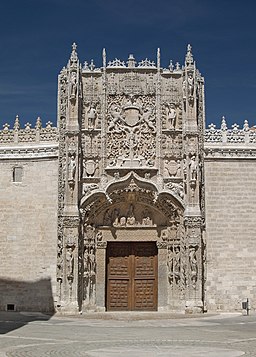In the Middle Ages, the city of Zamora was continually fought over by Moors and Christians, which is, perhaps, why this Castilian municipality has such impregnable looking ramparts. The city originally had three layers of fortification and the first of these walls has been preserved almost intact.
.JPG) |
The Duero & Zamora Cathedral
photo: public domain (Sira) |
Zamora stands on the northern bank of the River Duero that winds its way across Castile-Leon towards Portugal. The city's position has made it strategically important throughout history. In Roman times it lay on the road from Augusta Emerita (modern Mérida) to Caesaraugusta (modern Zaragoza). Zamora was especially important during the Christian Reconquest and the city passed between Arab and Christian hands on a number of occasions.
Zamora preserves many buildings from the Middle Ages with its walls, castle, palaces and religious buildings - so much so, that it has been declared a Historic-Artistic Site.
The 12th-century stone bridge, the Puente de Piedra, is a good place to start because it not only provides a tremendous view of the city but it is also the actual entrance to the historical quarter. Most of the historic sights of Zamora are located immediately to the north of the bridge whereas the cathedral and castle lie only half a kilometre in the westward direction.
Zamora Cathedral is most impressive. It was built in the 12th century and it is called the 'Pearl of the Duero'. It has a magnificent Byzantine cupola with fish-scale-like tiles and many other notable features that include an impressively sculptured Romanesque entrance - the Puerta del Obispo. Inside there are a number of richly decorated chapels, opulent altarpieces and intricately carved walnut choir stalls decorated with biblical figures and allegorical scenes. The Neoclassical cloister houses the Cathedral Museum.
 |
Zamora Cathedral - photo: public domain from
Project Gutenberg's 'The Cathedrals of Northern Spain' by Charles Rudy |
 |
Zamora Castle
photo: public domain
(Eduardo Alberto Sánchez Ferrezuelo) |
Much of Zamora Castle is preserved including its keep, doorway and moat. The fortress is of Arab origin and has a trapezoid ground floor and a polygonal tower. There are six turrets, which afford spectacular views of the city and the surrounding countryside. The fortress along with the three layers of walls provided the city with a fair degree of impregnability.
One of Zamora's nicknames is "ciudad del románico". This is because it has one of the greatest concentrations of Romanesque churches in Europe. In fact, many beautiful buildings are squeezed into its cobbled streets and plazas. Walking from the cathedral in the direction of the Plaza Mayor one encounters quite a few churches including the Romanesque San Pedro y San Ildefonso, La Magdalena and San Cipriano.
 |
San Juan de Puerta Nueva
photo: public domain (Jomajima) |
The impressive Church of San Juan de Puerta Nueva stands in the middle of the Plaza Mayor. This attractive square has two town halls - the current one and the Ayuntamiento Viejo, a solid 15th century building that was altered in the 17th century and which is now the police headquarters.
Just a short distance from Plaza Major is the Palacio de los Momos. It is the current home of the Provincial Court and is one of a number of palaces in the city. Another is the Palacio de Puñoenrostro, which is an excellent example of 16th century civil architecture. It is now the museum of Zamora. It is located near the stone bridge, in the Plaza de Santa Lucía.
I have covered just a few of the historic sights in Zamora. To do them all justice it would need more than one day and an excellent place to stay would be the local Parador de Turismo. It is housed in yet another enchanting building - the Palacio de los Condes de Alba y Aliste. It is a 15th-century Renaissance palace - a medieval jewel in the crown that is Zamora.
the above text is an extract from "Spanish Impressions"
ISBN 9781445225432more blogs by Robert Bovington...
"Photographs of Spain" | |
"postcards from Spain" | |
"you couldn't make it up!" | |
"a grumpy old man in Spain" | |
"bits and bobs" | |
"Spanish Expressions" | |
"Spanish Art" | |
"Books About Spain" | |
+pd+Dariorueda90.jpg)













